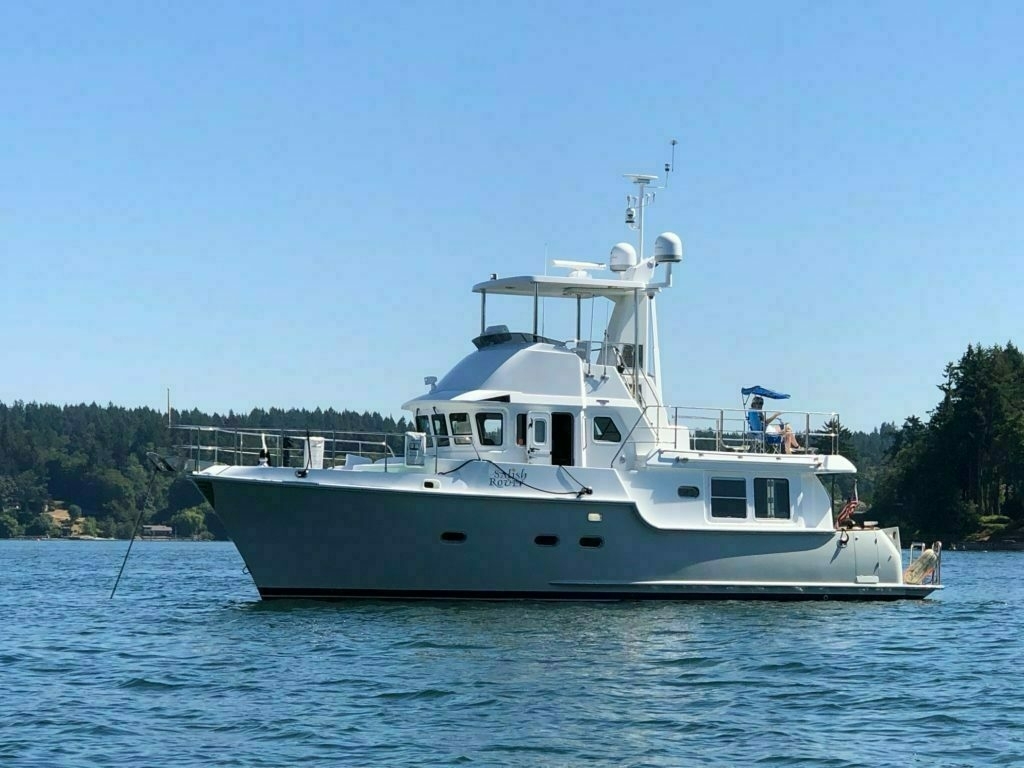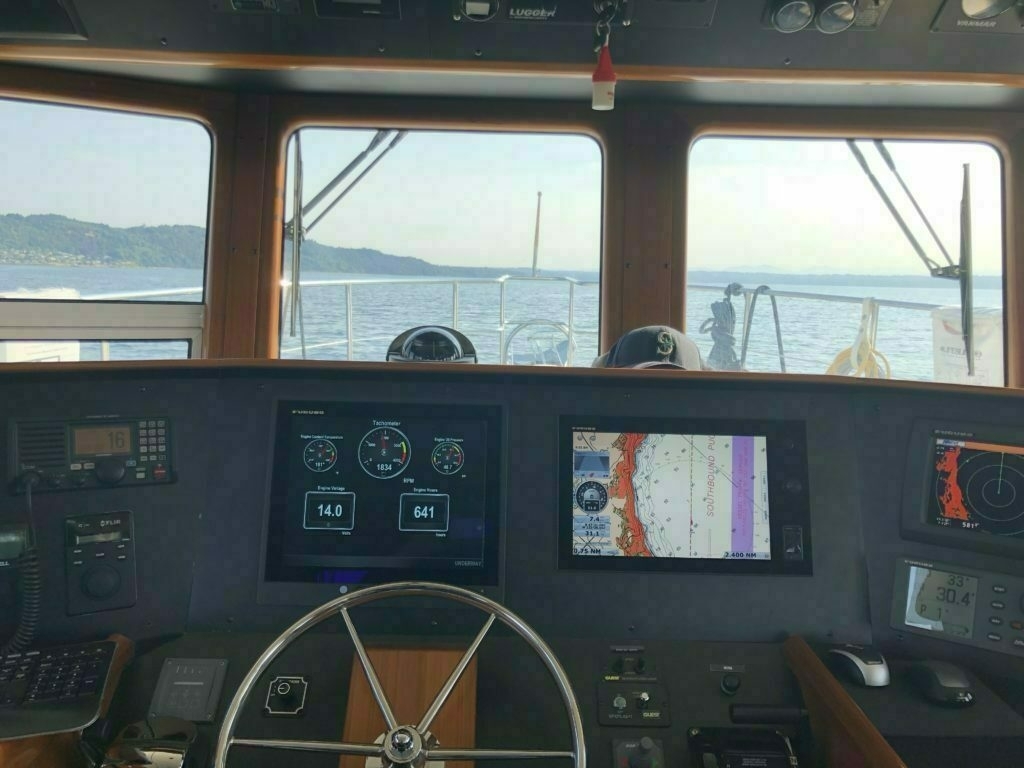A Sailor Crosses the Bar (Part Two)
After two decades of sailing, we have crossed over to the dark side.
A few weeks ago we bought a powerboat, a Nordhavn 43 trawler, that we’ve named Indiscretion. She isn’t a typical go-fast stinkpot kind of powerboat. Her cruising speed of 7 knots isn’t far off from sailing. We won’t win any races. But she’s a stout little ship, with the displacement and hull design to withstand open ocean conditions, and an engine and fuel supply to take us from Seattle to Hawaii on a single tank of diesel. A sistership circumnavigated the world a few years ago. We don’t expect to cross oceans, but we do have plans to go places that require blue water passages, up to Alaska or down to Mexico, and going there in a boat that can handle just about anything provides real peace of mind.

I knew letting go of sailing would be tough. For a long time, my happy place was at the helm of a boat under sail. No matter what might be stressing me out at work or at home, it fell away as my hand grasped the tiller, the engine noise died away to a blissful quiet, the sails filled and the boat put her shoulder down into the waves and wind. There’s so much to do to sail well, it took my whole attention, leaving little room to fret about anything else. And the connection to the wind and waves and water was magical, particularly at night with with the feel of wind on your cheek for sail trim and the amazing glow of phosphorous lighting your wake.
Yet as the years piled on, I found that my aging body wasn’t quite as lithe and agile as it once was to cope with the physicality of sailing. Low back pain turned into something worse a few years ago and it literally pained me to go sailing, though my desire for voyaging remained strong as ever.
So we turned to a logical alternative for old sailors: the trawler yacht. It turns out trawlers and sailboats have some things in common. First, as mentioned, they take a leisurely pace in getting places, relishing the journey more than the destination. Second, they are both fuel efficient, at least for boats. A trawler nearly rivals a sailboat for fuel efficiency while motoring, and is laughably better than those planing motor yachts. Finally, blue water models are quite seaworthy with many, many ocean crossings under their belts. These similarities brought us comfort as we climbed aboard trawler after trawler over months of boat shopping. We knew we found our boat when we stepped aboard a Nordhavn. Overbuilt, incredible build quality, redundant systems, a track record of open ocean journeys and a terrific support network of existing Nordhavn owners. Our 43' version is on the small side for Nordhavn, but perfect for our needs. After a little back and forth, a sea trial and survey, we proudly became the owners of this beautiful vessel.
For our maiden voyage, we “steamed” Indiscretion from Elliott Bay in Seattle to our home port here on Vashon Island, getting our first opportunity to experience what trawler life is like. Conditions were superb, temperatures in the eighties and calm seas, hardly a challenge for this go-anywhere vessel. The coastline streamed by faster than when sailing. I’ll admit that making a consistent 7 knots in the direction you actually wanted to go is damn refreshing after years and years of zig-zagging under sail. The boat is 60 thousand pounds with a full displacement keel which makes the ride steady and sure. Hydraulic stabilizer fins work like ducks feet below the water serving to smooth out the side to side roll from passing boat wakes. The low-RPM diesel engine buried deep in the bowels of the ship’s engine room serves up more of a low rumble than the high-pitched roar we suffered on our sailboats.
There have been a few times when I’ve been out in the rain and wind in the cockpit of a sailboat and cursed aloud at these big trawlers as they passed, the captain visible behind the steamed windows in the wheelhouse, perhaps sipping a hot cup of coffee from his high warm perch, maybe taking pity on my miserable wet self. Now that I have held that same perch myself, I marvel at the comfort and ease of passage-making these big trawlers afford. Had I known then what I know now, I would have cursed all the louder out there in my damp misery.

It’s not all downwind sailing though. This boat houses the equivalent of a small municipality’s worth of systems to decipher, operate and maintain. There are three different diesel engines, each with its own peculiarities and needs, a watermaker which can magically turn seawater to pure drinking water if you know how to keep it clean and happy, heating and cooling systems, hydraulics, pumps of all sorts and sizes, electronics spanning two different helm stations … the manuals alone for all these systems take up a good size shelf. In our first weeks of ownership, we have had these manuals out on the pilothouse table, scratching our heads over all the new terminology (what exactly is a galvanic isolator fault?) and trying to inch our way up a very steep ramp of learning. We have already enjoyed the generosity of our fellow Nordhavn owners who actively participate in an online forum to help out rank novices like us. So far, every question or problem we’ve encountered has been addressed before by someone in this treasure trove of online help. I’ve been thinking I needed a new challenge in my life and I think I may have found it with the upkeep of this sophisticated vessel.
We keep the boat at Quartermaster Marina on Vashon. It’s a low-key friendly marina without pretensions. I find myself down on the boat a lot these days, poring over system manuals, contorting my body into strange positions within electrical cabinets or storage lockers, and sometimes just relaxing in the wheelhouse, listening to music or a Mariners game, enjoying the beautiful nautical space. During my time on the boat, many longtime marina friends have stopped by for a tour and a beer. The novelty of a new boat at the marina has a magnetic appeal and I’ve already met a lot more of my fellow boaters here at the marina simply by being aboard and welcoming a tour of the boat and a cold drink. As you should know, boaters are some of the best people on earth and our marina has more than its fair share of these kind souls.
While relaxing and socializing at the dock is fun, it’s the voyaging we truly love. So far, we’ve only taken short shakedown trips around Puget Sound: Blake Island, Elliott Bay, Penrose Point, all within a half day’s motoring. These have been useful trips as we learn the boat and all its intricacies. Last night we anchored off the port of Silverdale in Dyes Inlet for a couple of days of gunkholing. We’ll take more weekend trips like these through the fall and winter as we gain confidence. We’re talking about spending Christmas in Victoria aboard the boat, an absurd idea aboard our sailboat, but warm and inviting on a trawler. Then, next summer we’ll return to the San Juan and Gulf Islands to see what’s changed in our old sailing stomping grounds, with a bucket-list trip up the inside passage to Alaska the following year, and beyond that? We’d love to take this boat down the coast for a winter in Mexico. I know this boat could handle it. We’ll have to see about the captain and crew.
So that’s it, then. We’ve shed our sailing skins and are slowing finding our way in this grand trawler. This morning as I sip my first cup of coffee and look out over the quiet bay with the boat’s mirror image captured in the still water from my perch on the flybridge, it’s hard not to be moved by the amazing vista an anchored boat provides. Sailors, kayakers, fisherman, stinkpotters, 150-foot mega yachters, and us trawler types all share that same passion for water. Perhaps the salt content of our blood is just slightly higher than normal, pulling us back to the ocean of our long ago birth. I count myself a lucky member of that large seafaring tribe.